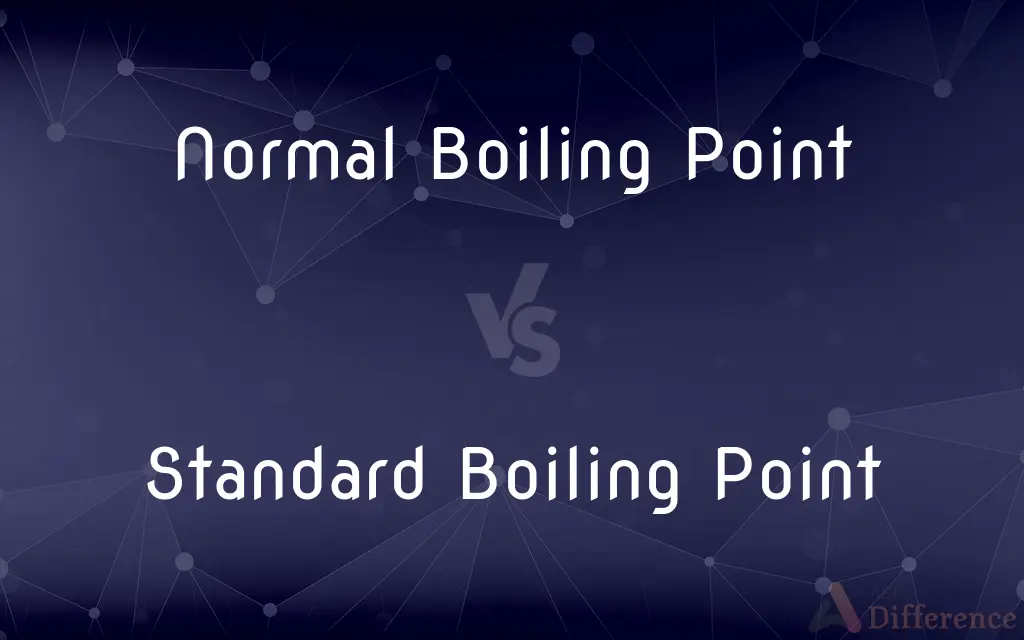Normal Boiling Point vs. Standard Boiling Point — What's the Difference?
By Maham Liaqat & Fiza Rafique — Published on July 15, 2024
The normal boiling point is the temperature at which a liquid boils at 1 atmosphere of pressure, whereas the standard boiling point is defined as the boiling temperature at a fixed pressure of 1 bar.

Difference Between Normal Boiling Point and Standard Boiling Point
Table of Contents
ADVERTISEMENT
Key Differences
The normal boiling point is a specific temperature for the phase transition from liquid to gas under atmospheric pressure, traditionally considered to be 1 atm (101.325 kPa). This measurement is crucial for characterizing the physical properties of substances at conditions close to those found at sea level on Earth.
The standard boiling point, on the other hand, is measured at a slightly different pressure of 1 bar (100 kPa), which was adopted as a standard to streamline scientific communication and research. Although the difference in pressure between 1 atm and 1 bar is relatively small, it leads to slight variations in the boiling point temperatures reported.
The distinction between these two measures is important in scientific research and applications where precise boiling temperatures are necessary for calculations, such as chemical engineering and materials science. The choice of reference pressure (1 atm vs. 1 bar) can affect experimental outcomes and theoretical models.
The normal boiling point is more commonly used in educational contexts and everyday situations, whereas the standard boiling point is preferred in professional and scientific settings for its consistency with the International System of Units (SI). The shift towards the standard boiling point reflects an ongoing effort to unify measurements under a single set of standards.
In practice, the difference in the boiling points measured at 1 atm and 1 bar is minimal, but acknowledging this distinction is important for accuracy in scientific documentation and research. Both concepts serve to provide reference points for understanding the behavior of substances under varying thermal conditions.
ADVERTISEMENT
Comparison Chart
Pressure Reference
1 atmosphere (101.325 kPa)
1 bar (100 kPa)
Common Usage
Educational, everyday contexts
Scientific, professional settings
Purpose
Characterize boiling at Earth's sea level conditions
Standardize measurements across scientific research
SI Consistency
Less consistent with SI
More consistent with SI
Impact of Difference
Minimal in everyday use
Important for precision in scientific research
Compare with Definitions
Normal Boiling Point
Used to describe the boiling behavior of substances under common conditions.
Ethanol has a normal boiling point of 78.37°C.
Standard Boiling Point
Critical for precision in chemical and physical research.
The standard boiling point of mercury is used in thermometry.
Normal Boiling Point
The temperature at which a liquid boils at 1 atmosphere of pressure.
Water's normal boiling point is 100°C.
Standard Boiling Point
Aligns with the International System of Units for consistency.
Scientific studies report boiling points at 1 bar for uniformity.
Normal Boiling Point
Influences engineering and design of everyday appliances.
Pressure cookers adjust the boiling point for faster cooking.
Standard Boiling Point
The boiling temperature of a liquid at a pressure of 1 bar.
The standard boiling point of water is slightly less than 100°C.
Normal Boiling Point
It reflects boiling conditions most familiar in everyday life.
Cooking instructions are based on water boiling at 100°C at sea level.
Standard Boiling Point
Essential for accurate thermodynamic calculations.
Calculating the energy required for phase changes involves the standard boiling point.
Normal Boiling Point
Important for understanding weather and climate phenomena.
The boiling point of water decreases with altitude, affecting cooking at high elevations.
Standard Boiling Point
Affects the design and operation of laboratory and industrial equipment.
Distillation processes are optimized using standard boiling points.
Common Curiosities
Why is the standard boiling point important in research?
It provides a consistent reference for comparing data and conducting experiments across different laboratories and studies.
How significant is the difference between the normal and standard boiling point?
The difference is minimal but important for precise scientific work.
Does the normal boiling point vary with altitude?
Yes, because atmospheric pressure decreases with altitude, leading to lower boiling temperatures.
How do changes in the boiling point affect daily life?
Variations can affect cooking times, heating systems, and weather patterns.
Does the boiling point affect the state of matter?
Yes, the boiling point is a key temperature for the phase transition between liquid and gas states.
How do pressure cookers manipulate boiling points?
By increasing the pressure inside the cooker, raising the boiling point of water and cooking food faster.
How do scientists use boiling points in distillation?
By exploiting differences in boiling points to separate components of a mixture.
Why are there two different standards for boiling point?
To accommodate both everyday and scientific needs, reflecting historical conventions and the push for SI consistency.
Can atmospheric pressure variations affect the boiling point?
Yes, both the normal and standard boiling points assume specific pressure conditions; variations in actual atmospheric pressure can alter the observed boiling temperature.
Is one measure more correct than the other?
Neither is more correct; the choice depends on the context and requirements of the application.
Are boiling points the same for all substances at 1 atm and 1 bar?
While the reference pressures are close, each substance will have slightly different boiling points at these pressures due to their unique physical properties.
Can boiling points be used to identify substances?
Yes, the boiling point is a characteristic physical property useful for substance identification.
Why did the scientific community adopt 1 bar instead of 1 atm?
To align more closely with the SI system, which standardizes measurements for global consistency.
How is the boiling point measured?
By heating a liquid and observing the temperature at which it transitions to a gas at a specified pressure.
What role do boiling points play in environmental science?
Understanding boiling points helps in studying climate change, evaporation rates, and the behavior of pollutants.
Share Your Discovery

Previous Comparison
Gel vs. Wax
Next Comparison
Volvo vs. ScaniaAuthor Spotlight
Written by
Maham LiaqatCo-written by
Fiza RafiqueFiza Rafique is a skilled content writer at AskDifference.com, where she meticulously refines and enhances written pieces. Drawing from her vast editorial expertise, Fiza ensures clarity, accuracy, and precision in every article. Passionate about language, she continually seeks to elevate the quality of content for readers worldwide.














































